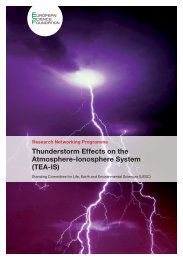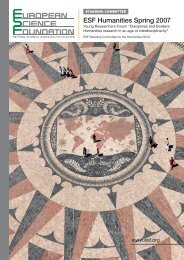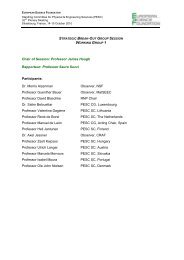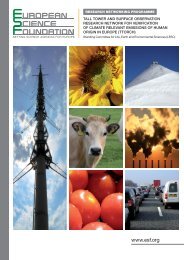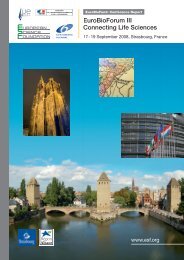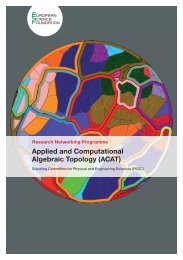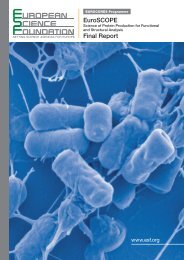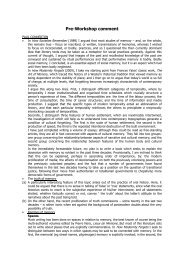Nanomedicine - European Science Foundation
Nanomedicine - European Science Foundation
Nanomedicine - European Science Foundation
You also want an ePaper? Increase the reach of your titles
YUMPU automatically turns print PDFs into web optimized ePapers that Google loves.
30<br />
4. RECOMMENDATIONS AND SUGGESTED ACTIONS<br />
standing of initiation and progression of disease<br />
• development of novel nanotechniques for monitoring<br />
in real time cellular and molecular processes<br />
in vivo and for molecular imaging to study pathological<br />
processes in vivo, with improved sensitivity<br />
and resolution<br />
• identification of new biological targets for imaging,<br />
analytical tools and therapy<br />
• translation of research based on molecular imaging<br />
using nanoscale tools from animal models to<br />
clinical applications<br />
• closing of the gap between the molecular and<br />
cellular technologies and the clinical diagnostic<br />
nanotechnologies<br />
Specific developments should include:<br />
longer term<br />
• development of a multimodal approach for nanoimaging<br />
technologies<br />
• design of non-invasive in vivo analytical nanotools<br />
with high reproducibility, sensitivity and reliability<br />
for use in pre-symptom disease warning signal,<br />
simultaneous detection of several molecules,<br />
analysis of all sub-cellular components at the<br />
molecular level, and replacement of antibodies as<br />
detection reagents by other analytical techniques<br />
4.2.3. Novel Therapeutics and Drug Delivery<br />
Systems<br />
Specific developments should include:<br />
short term<br />
• application of nanotechnology to develop multifunctional<br />
structured materials with targeting capabilities<br />
or functionalities allowing transport across<br />
biological barriers<br />
• nanostructured scaffolds (tissue engineering),<br />
stimuli-sensitive devices and physically targeted<br />
treatments<br />
• a focus on cancer, neurodegenerative and cardiovascular<br />
diseases and on local-regional delivery<br />
(pulmonary/ocular/skin)<br />
Specific developments should include:<br />
longer term<br />
• a synthetic, bioresponsive systems for intracellular<br />
delivery of macromolecular therapeutics and<br />
bioresponsive/self-regulated delivery systems<br />
(smart nanostructures such as biosensors coupled<br />
to delivery systems)<br />
4.2.4. Clinical Applications and Regulatory<br />
Issues<br />
General directions should be:<br />
• disease-oriented focus for <strong>Nanomedicine</strong> development<br />
in specific clinical applications<br />
• case-by-case approach for clinical and regulatory<br />
evaluation of <strong>Nanomedicine</strong>s<br />
• highly prioritised communication and exchange of<br />
information among academia, industry and regulatory<br />
agencies with a multidisciplinary approach<br />
4.2.5. Toxicology<br />
General directions should be:<br />
• improved understanding of toxicological implications<br />
of nanomedicines in relation to material properties<br />
and proposed use by the potentially predisposed,<br />
susceptible patient<br />
• thorough consideration of the potential environmental<br />
impact, manufacturing processes and ultimate<br />
clinical applications in toxicological investigations<br />
for nanomedicines<br />
• risk-benefit assessment for both acute and longterm<br />
effects of nanomedicines with special consideration<br />
on the nature of the target disease<br />
• a shift from risk assessment to proactive risk<br />
management at the earliest stage of new nanomedicines<br />
discovery and development<br />
4.3. Research Strategy and Policy<br />
4.3.1. Organisation and Funding<br />
Recommendations<br />
• improved coordination and networking of research<br />
activities and diverse range of funding sources at<br />
the <strong>European</strong>, national and regional levels<br />
• creation of new <strong>Nanomedicine</strong>-targeted funding<br />
schemes to better facilitate both transdisciplinary<br />
and interface research that is critical for success in<br />
<strong>Nanomedicine</strong><br />
• establishment of <strong>European</strong> Centres of Excellence<br />
in the field of <strong>Nanomedicine</strong><br />
• modification of funding mechanisms for basic<br />
technological research to permit academic-grouponly<br />
applications<br />
• development of funding procedures with sufficient<br />
scale and scope; for example with longer term<br />
funding rather than continuous short-term funding<br />
cycles, to enable research for seriously tackling<br />
goal-oriented problems<br />
• establishment of economic and social benefits of<br />
<strong>Nanomedicine</strong> and communication of them to<br />
stakeholders and the public<br />
Suggested Action<br />
• coordinated funding of basic research in <strong>Nanomedicine</strong><br />
through ESF EUROCORES and <strong>European</strong><br />
Commission FP7 instruments (e.g. ERA-Net)




